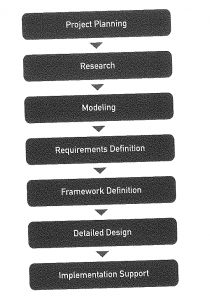“Design is the craft of visualising concrete solutions that serve human needs and goals within certain constraints” a important concept that is unpacked in this reading by Kim Goodwin. Visualising concrete solutions is where designers must excel at looking something blank and filling it with believable representations of an end product, so that others can see, understand and eventually build it. Craft is neither sci nor art but somewhere in between. Serve human needs and goals is where good design helps humans accomplish something in an efficient, effective, safe, and enjoyable ways. at same time, designers strive to go beyond the simply functional, since pleasure & aesthetic satisfactoion are also impt human goals. Within certain constraints just suggest that is no such thing as unconstrained design.
She also mentioned about “goal-directed design” for the approach towards product and service design where it places focus on achieveing goals. In it, are four components: principles, patterns, process & practices. Principles being guidelines for creating good solutions under specific circumstances but what is appropriate to one context may not apply to another. Patterns are types of solutions that tend to be useful for certain classes of problems. Process are the steps and techniques involved in planning and conducting design research, using it to develop personas, scenarios, and requirements, then using those to develop and iterate a design solution.
I personally really appreciate this framework where I think I find myself following for certain projects. Under modelling, she mentioned the importance of “personas”, user archetypes that help you make design decisions and communicate your rationale. Often times we lose sight of who we are the target audiences due to more ambitious idea where we want to include all and everyone (which is actually impossible as everyone is different and you just can’t please all). Hence I think it is really important to stick to those “personas” and focus on them only to truly be designing for those user archetypes.
There were also three kinds of framework mentioned under requirements definition – interaction framework (outlines how functionality is grouped and how the personas will accomplish the most critical tasks), visual framework (expresses th brand’s qualities in concrete terms, typically using design language studies divorced from the interaction design) and industrial design framework (consists of an approx. form factor and componeat architecture, physical expression of the brand developed in conjunction with the visial desian language, and a description of any hardware controls tht are essential to the interaction).
However no matter designing for anything, I think the overview (image above) can be a useful guide and backbone even if this is for goal-directed process, it could also apply for human-centered design? I feel like they may be two quite different things but somehow I feel there is still a connection and interrelatedness. (Just a thought after reading this.)
Question 1: Goal-directed design or human-centered design? Can it be a combination?
Question 2: Are there situations where goal-directed design can be actually be a not so good way to go for product and service design? What can applied then if so?
Featured Image from here.








